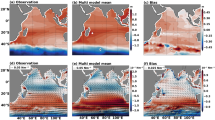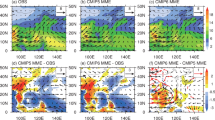Abstract
Using observation data and outputs from the “twentieth-century climate in coupled models” (20c3m) control runs of coupled general circulation models submitted to the Coupled Model Intercomparison Project, phase 3 (CMIP3), the ability of CMIP3 models to simulate the Indian Ocean subtropical dipole (IOSD) and its influence on the rainfall anomaly over the southern African region is investigated. Many models simulate the IOSD, but the location and shape of the sea surface temperature anomaly vary among models. This model bias is closely linked to the bias in simulating the anomalous strengthening and southward shift of the subtropical high. Almost all models fail to simulate the rainfall anomaly associated with the IOSD owing to the inaccurate simulation of the location of sea surface temperature and sea level pressure anomalies.














Similar content being viewed by others
References
Rayner NA et al (2003) Global analysis of sea surface temperature, sea ice, and night marine air temperature since the late nineteenth century. J Geophys Res 108. doi:10.1029/2002JD002670
Annamalai H, Hamilton K, Sperber KR (2007) The South Asian summer monsoon and its relationship with ENSO in the IPCC AR4 simulations. J Clim 20:1071–1092
Behera SK, Yamagata T (2001) Subtropical SST dipole events in the southern Indian Ocean. Geophys Res Lett 28:327–330
Behera SK, Salvekar PS, Yamagata T (2000) Simulation of interannual SST variability in the tropical Indian Ocean. J Clim 13:3487–3499
Chiodi AM, Harrison DE (2007) Mechanism of summertime subtropical southern Indian Ocean sea surfaces temperature variability: on the importance of humidity anomalies and the meridional advection of water vapor. J Clim 20:4835–4852
Fauchereau N, Trzaska S, Richard Y, Roucou P, Camberlin P (2003) Sea-surface temperature co-variability in the southern Atlantic and Indian Oceans and its connections with the atmospheric circulation in the southern hemisphere. J Clim 23:663–677
Hermes JC, Reason CJC (2005) Ocean model diagnosis of interannual coevolving SST variability in the South Indian and South Atlantic Oceans. J Clim 18:2864–2882
Huang BH, Shukla J (2008) Interannual variability of the South Indian Ocean in observation and a coupled model. Indian J Mar Sci 37:13–34
Kalnay E et al (1996) The NCEP/NCAR 40-years reanalysis project. Bull Am Meteor Soc 77:437–471
Legates DR, Willmott CJ (1990) Mean seasonal variability in gauge-corrected, global precipitation. J Clim 10:111–127
Mason SJ (1995) Sea-surface temperature—South African rainfall associations, 1910–1989. Int J Climatol 15:119–135
Meehl GA, Covey C, Delworth T, Latif M, McAvaney B, Mitchell JFB, Stouffer KJ, Taylor KE (2007) The WCRP CMIP3 multimodel dataset: a new era in climate change research. Bull Am Meteorol Soc 88:1383–1394
Miyasaka T, Nakamura H (2010) Structure and mechanisms of the southern hemisphere summertime subtropical anticyclones. J Clim 23:2115–2130
Morioka Y, Tozuka T, Yamagata T (2010) Climate variability in the southern Indian Ocean as revealed by self-organizing maps. Clim Dyn 35:1059–1072
Morioka Y, Tozuka T, Masson S, Terray P, Luo J, Yamagata T (2011) Subtropical dipole modes in a coupled general circulation model. J Clim (in revision)
North GR, Bell TL, Cahalan RF, Moeng FJ (1982) Sampling errors in the estimation of empirical orthogonal functions. Mon Weather Rev 110:699–706
Reason CJC (2001) Subtropical Indian Ocean SST dipole events and southern African rainfall. Geophys Res Lett 28:2225–2227
Suzuki R, Behera SK, Iizuka S, Yamagata T (2004) Indian Ocean subtropical dipole simulated using a couple general circulation model. J Geophys Res 109. doi:10.1029/2003JC001974
Terray P, Dominiak S (2005) Indian Ocean sea surface temperature and El Niño-Southern Oscillation: a new perspective. J Clim 18:1351–1368
Terray P, Dominiak S, Delecluse P (2005) Role of the southern Indian Ocean in the transitions of the monsoon-ENSO system during recent decades. Clim Dyn 24:169–195
Terray P, Chauvin F, Douville H (2007) Impact of the southeast Indian Ocean sea surface temperature anomalies on monsoon-ENSO-dipole variability in a coupled ocean-atmosphere model. Clim Dyn 28:553–580
Tyson PD, Preston-Whyte RA (2004) The weather and climate of southern Africa. Oxford University Press, Oxford
Uppala SM et al (2005) The ERA-40 re-analysis.Q J R Meteorol Soc 131:2961–3012
Washington R, Preston A (2006) Extreme wet years over southern Africa: Role of Indian Ocean sea surface temperatures. J Geophys Res 111. doi:10.1029/2005JD006724
Washington R, Todd M (1999) Tropical-Temperate links in southern African and southwest Indian Ocean satellite-derived daily rainfall. Int J Climatol 19:1601–1616
Xie PP, Arkin PA (1997) Global precipitation: a 17-year monthly analysis based on gauge observations, satellite estimates and numerical model outputs. Bull Am Meteorol Soc 78:2539–2558
Yoo SH, Fasullo J, Yang S, Ho CH (2010) On the relationship between Indian Ocean sea surface temperature and the transition from El Niño to La Niña. J Geophys Res 115. doi:10.1029/2009JD012978
Acknowledgments
We acknowledge the modeling groups for making their simulations available for analysis, the Program for Climate Model Diagnosis and Intercomparison (PCMDI) for collecting and archiving the CMIP3 model output, the WCRP’s Working Group on Coupled Modeling (WGCM) for organizing the model data analysis activity. The WCRP CMIP3 multi-model dataset is supported by the Office of Science, U.S. Department of Energy. The present research is supported by Japan Science and Technology Agency (JST) and Japan International Cooperation Agency (JICA) through Science and Technology Research Partnership for Sustainable Development (SATREPS), and Japan Society for Promotion of Science through Grant-in-Aid for Scientific Research (B) 20340125. The first author is financially supported by the Sasakawa Scientific Research Grant from the Japan Science Society.
Author information
Authors and Affiliations
Corresponding author
Rights and permissions
About this article
Cite this article
Kataoka, T., Tozuka, T., Masumoto, Y. et al. The Indian Ocean subtropical dipole mode simulated in the CMIP3 models. Clim Dyn 39, 1385–1399 (2012). https://doi.org/10.1007/s00382-011-1271-2
Received:
Accepted:
Published:
Issue Date:
DOI: https://doi.org/10.1007/s00382-011-1271-2




